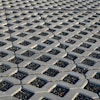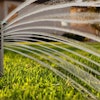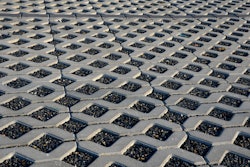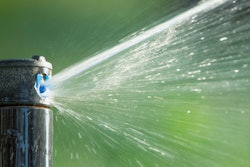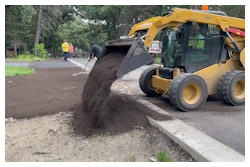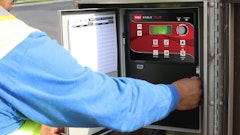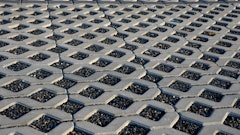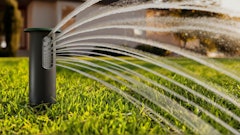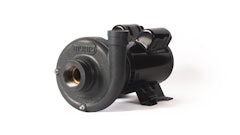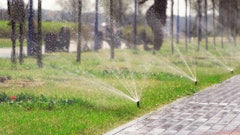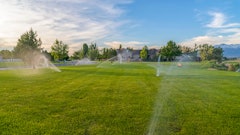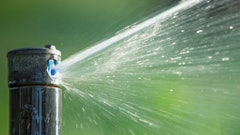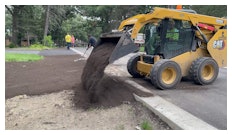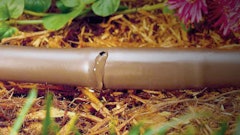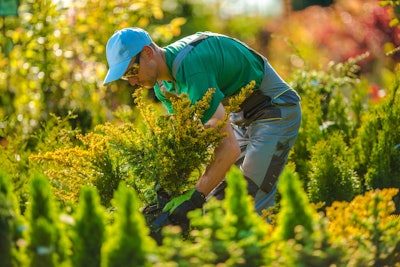
Ask a room full of growers how they want to improve their substrate (i.e. growing media) and you’ll hear a dozen different answers. These will commonly include “I want to ensure my new mix has good drainage,” “I want better drainage,” “my substrate is too wet,” and “I want a drier mix.” The actuality is that substrate “drainage” is a poor characterization for soilless substrates and entails many factors. In soil science, drainage is defined as the rate and extent of water movement through and across the soil. But that definition is inadequate when referring to substrates, where different substrate blends are used in confined containers of a fixed volume and height.
In simplest terms, drainage of a substrate in a container should be defined as how fast and what volume of water would come out of the bottom of the pot when irrigating. This definition provides little insight into what production horticulturists changed in their substrate. In this article, we hope to better define the individual phenomena that we believe are being described when horticulturists are referring to “drainage” in soilless substrate mixtures. With this understanding, production horticulturists can better define problems and opportunities when making new substrates, refining existing substrates, or altering irrigation scheduling.
This begins by thinking about specific phenomena that occur when producing a plant. How water gets into the substrate surface (i.e. infiltration), how water is stored (i.e. physical properties) and how it moves through the substrate (i.e. hydraulic conductivity) for a given container’s shape and height. This, in turn, affects how air space and gas exchange change over time — all while still ensuring your substrate delivers enough water between irrigations to avoid plant stress. Each is in part a result of how substrate components (e.g. peat and HydraFiber) interact to create pores in given containers and the fluctuating air space due to irrigation scheduling, root growth and changing substrate constituents over time.
Redefining 4 Drainage Terms
Pore Size
Pores occurring between substrate particles, either filled with air or water, differ in size due to the intermingling of particles when mixing substrate components and how one fills the container — tapping a pot or exerting pressure on the surface during filling. For example, a horticultural perlite may provide increased air space relative to a fine peat by creating larger pores. However, perlite would fill in larger pores in a bark-based substrate, decreasing air space. If either substrate’s density is increased or compressed during potting, the pores change size and shape, typically resulting in increased water retention and decreased air space.
The ability for the substrate’s void space or total pores (70 to 90 percent by volume) to be filled with water or air is the result of two opposing forces. There’s the water matric potential, where water is retained between smaller pores due to capillary action and on the surface of particles through water’s attraction to the particle’s surface. This is opposed by the force of gravity pulling down water to the bottom of the container or gravitational potential. The pores that are unable to retain water provide the air space needed for roots to respire.
It’s a delicate balancing act. Water is continually removed from the substrate by transpiration, roots sucking up water, and evaporation from open surfaces of the container that include the top, drain holes, and even sides if perforated. Water is also routinely added back through irrigation, refilling pores with water.
We refer to the proportion of the substrate holding water after being thoroughly watered, drained, and thus fully hydrated as “container capacity,” which is synonymous with “water holding capacity.” Horticultural practitioners control the volumetric water — the dynamic measure of water in the container throughout production based on volume — and air content through the substrate by a combination of having desirable pore sizes and distribution, container height, and irrigation scheduling. The “air space” reported by a laboratory is the minimum air space at a given height when a substrate is fully hydrated and drained or at container capacity.
More about soil health on GreenIndustryPros.comThe Benefits of Soil Enhancement - Find out how to enhance plant growth, nutrient cycling, water retention and overall ecosystem health with soil enhancement. Why Soil Quality Matters to Landscape Pros - Studies have demonstrated that by enhancing soil structure and fertility, landscape professionals can reduce dependency on chemical fertilizers and irrigation, resulting in lower operational costs. Here's how to do so. How Soil Health Can Impact Site Success - A good soil health management system can bring ROI within five to ten years. |
Infiltration
Infiltration refers to how fast water enters the substrate. The movement of water into the substrate is influenced by the fineness and wettability of the substrate. A fine or hydrophobic, water-repellent substrate will pool water on the surface. A coarser substrate or hydrophilic, water-loving substrate allows water to readily enter. The use of wetting agents can aid in infiltration to a degree.
Hydraulic Conductivity
Hydraulic conductivity is the rate of water movement in the container. The rate of movement can be measured under saturated or unsaturated, partially wet or moist conditions. Unsaturated hydraulic conductivity is used for all practical applications in a substrate since there is never a time when all pores are filled with water.
 Profile Products LLC
Profile Products LLC
Fine particles and fiber substrate components (e.g. coir, peat, wood fiber) increase unsaturated hydraulic conductivity due to particle size and greater pore connectivity. Coarse substrates have pores that vary greatly in size and are more likely to have preferential flow in which water goes through channels and only wets a portion of the substrate instead of spreading across the entire profile. This is most pronounced in dry substrates and typically decreases with increasing volumetric water content of the substrate. Preferential flow results in poor wetting of the substrate and the inability to reach maximum water-holding capacity throughout production. Preferential flow can be decreased by ensuring proper substrate moisture at the time of mixing and when filling containers, the addition of fiber and the use of wetting agents. Growers may also consider adding water-soluble fertilizer or agrichemical drenches directly following a rain event or irrigation rather than replacing an irrigation event to minimize leaching.
Container Height
Container height directly impacts gravitational potential. A short container will retain more water than a tall container with the same substrate. If irrigated containers of varying height are placed side by side and filled with the same substrate, you would find the same volumetric water content value in each container at the same height, and the very bottom of each container will be saturated.
The selection of young plant tray depths has such an influence on the watering regime when germinating seed, rooting, cutting, and hardening a tissue culture plantlet. The more recent adoption of open cell liners that are wrapped in paper or mesh allow for more even drying and greater air exchange, promoting greater ease of root development. The perforated bottoms of young plant trays and purposeful large moisture swings when growing in closed cell systems are needed to allow for similar air exchange.
The Evolution of a Mix
Lastly, every substrate is always evolving. Each component starts with known physical properties, maximum water-holding capacity, and minimum air space. However, when growers begin to blend components, they intermingle and alter the static and dynamic physical properties, which are further affected by your potting method. The result is a “soup” where one ingredient plus another ingredient or component will not equal the total volume of the two components, with each contributing to the whole differently.
As plants grow, the hydraulic properties of the substrate continue to change. Roots alter pore sizes, the substrate ages and breaks apart to fill pores, or wash out, and agrochemical applications can affect wettability. Growers further control water availability, air space, and gas exchange at any given time through irrigation management practices. Thus, horticultural producers start with a well drained or airy mix that is forgiving as the substrate evolves. This approach provides breathing room as the substrate evolves, but also may be wasteful or cause issues early in production. This is one reason we use different substrate mixes for young plants, liners, and finished stock.
Balancing water air and water in containers can be better understood by paying attention to pore structure, infiltration, container height, and how substrate evolves, and irrigation scheduling. Consider these factors when next making new or refining your substrate mixtures.


